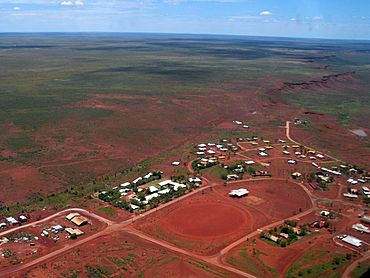Balgo, Western Australia facts for kids
Quick facts for kids BalgoWestern Australia |
|
|---|---|

Balgo viewed from the air
|
|
| Time zone | AWST (UTC+8) |
| LGA(s) | Shire of Halls Creek |
Balgo is a small community in Western Australia. It is located where the Great Sandy Desert and the Tanami Desert meet. This area is part of the Shire of Halls Creek, found off the Tanami Road.
Balgo was first set up by German missionaries in 1939. In 2021, about 430 people lived in Balgo. It was once known as Balgo Hills or Balgo Mission.
Contents
History of Balgo
The Balgo community began when German Pallottine Catholic missionaries arrived in 1939. A bishop named Otto Raible and Ernest Worms, with help from a local politician, found a large area for a "native mission". The bishop chose a spot about 60 kilometres (37 miles) south of Lake Gregory. He called this place Bishopdale.
When World War II started, the Australian government saw the missionaries as "enemy aliens". Their radio and guns were taken away by the police. After trying other locations, the current site for Balgo was chosen in 1942.
In the 1980s, the federal government helped fund Balgo. It became an outstation, which is a smaller Aboriginal community away from a main centre.
People and Languages
The name Balgo might come from the Kukatja language word palkurr-palkurr. This word means "rice grass," which grows in the area. The Kukatja people are closely linked to this community.
The Kukatja dialect of the Western Desert Language is the main language for many people in Balgo. The Luurnpa Catholic School has even published a Kukatja dictionary. At the school's Walkala Centre, they create audio books in both Kukatja and English.
Balgo is a diverse community with many different Aboriginal peoples. Besides Kukatja, seven other language groups are spoken there. These include Ngardi, Djaru, Warlpiri, Walmajarri, Wangkajunga, Pintupi and Ngaatjatjarra.
In 2019, scientists from the University of Queensland studied the Kukatja language. They found that people of all ages and from different groups spoke it fluently. Researchers recorded conversations and mapped the language. They believed Kukatja could show how languages spread around the world. They also worked on a dictionary and a guide for teachers.
Amazing Artists
In the 1980s, Balgo became well-known for its artists' cooperative. This group started when some artists from the famous Papunya Tula movement moved to Balgo. Some of the talented artists from Balgo include Susie Bootja Bootja Napaltjarri, Topsy Gibson Napaljarri, Eubena Nampitjin, Elizabeth Nyumi, Boxer Milner, Tjumpo (Bill) Tjapanangka, and "Helicopter" Tjungurrayi.
The Warlayirti Artists Aboriginal Corporation was set up in Balgo in 1987. It supports over 300 artists from Balgo, Kururrungku (Billiluna), and Mulan. These artists create works using many different materials and styles.
This art centre is the oldest of its kind in Western Australia. In August 2022, it celebrated its 35th anniversary with a special art show. The show was called Ngurra Kutjuwarra (On Country Together). This was a big event, especially after the centre was isolated for much of the COVID-19 pandemic in Australia.
Lost and Found Paintings
In the early 1980s, a group of Kukatja and Warlpiri men in Balgo painted their stories on wooden boards. These paintings disappeared for many years. Then, in 2019, more than 20 of these artworks were found by chance. They were in a sea container in Wyndham, about 50 kilometres (31 miles) away.
The paintings were in very poor condition. The South Australian Museum (SAM) was told about the find. Experts at Artlab Australia in Adelaide carefully fixed them. In October 2021, these restored paintings were shown in an exhibition at the museum. The show was called Balgo Beginnings. It also featured new artworks by the children and grandchildren of the original artists.
A book about the art, Balgo: Creating Country, was also launched. The money from book sales helps to provide a dialysis service in Balgo. This service helps people with kidney problems.
How Balgo is Run
The community of Balgo is managed by the Wirrimanu Aboriginal Corporation. This group was officially formed in 1984. They help make decisions for the community.
Balgo is also part of the Tjurabalan People's native title claim area. This means the Tjurabalan People have special rights to their traditional lands.
A plan for the town, called Balgo Layout Plan No. 3, was approved in 2005. This plan helps guide how the community grows and develops.
Community Facilities
Balgo has several important facilities for its residents. These include a petrol station, a supermarket, a Catholic church, and the Luurnpa Catholic School (for students from kindergarten to Year 10). There is also a Kutjungka Trade Training Centre, a clinic, and a police station.
The Wirrimanu Community Store is a small shop owned and run by a local Indigenous group. Goods are brought in by truck every two weeks. They travel all the way from Adelaide and Alice Springs. Because it's a small store, prices can be high. For example, a large pumpkin cost AUD$28 in 2023.
The Balgo Hill Airport is located about 1 nautical mile (1.9 km) south of Balgo. This airport helps people travel to and from the community.
In January 2020, the Australian Government announced plans to improve the Tanami Road. This road and its smaller feeder roads are very important. Making the main road from gravel into a sealed road will make it safer and more comfortable to drive on. This 300-kilometre (190-mile) stretch is the only way to reach nearby towns and bring in essential supplies. A new tourist road in Balgo will also help local guides take visitors to important cultural sites.
See also
 In Spanish: Balgo (Australia) para niños
In Spanish: Balgo (Australia) para niños


